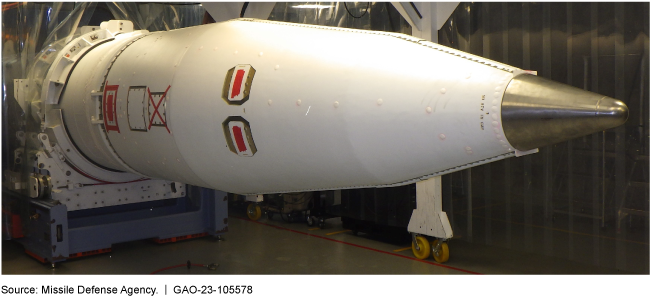Missile Defense: DOD Needs to Improve Oversight of System Sustainment and Readiness
Fast Facts
DOD's Missile Defense Agency develops systems to detect attacks and track, intercept, and destroy missiles in flight. MDA shares responsibility for operating and maintaining these systems with the military services.
This shared sustainment responsibility can be difficult when MDA and the services have different priorities for different parts of the system. DOD doesn't have a specific entity that oversees sustainment decisions for the whole system.
The military services and MDA report missile defense readiness data differently, making it more difficult to assess if the systems meet the military's needs. Our recommendations address these issues.
Ground Based Interceptor Undergoing Maintenance at Fort Greely, Alaska

Highlights
What GAO Found
The Department of Defense (DOD) lacks comprehensive guidance for sustaining Missile Defense System (MDS) elements, such as missile interceptors, sensors, and communications. The Missile Defense Agency (MDA) is responsible for acquiring and developing MDS elements. MDA and the military services have developed element-specific sustainment plans. However, DOD:
- has not identified a specific entity assigned with responsibilities for overseeing the sustainment of MDS. No one entity has been assigned responsibility per DOD guidance for overseeing the sustainment of MDS elements, resulting in a lack of visibility of MDS sustainment needs.
- does not have an approach for prioritizing efforts to address sustainment challenges for MDS. There is no approach for prioritizing and making department-wide sustainment decisions. For example, while MDA and the Army recognized corrosion as a challenge, the Army had not constructed permanent facilities for the element to prevent corrosion due to the prioritization of other projects and resource constraints.
Absent comprehensive guidance, including a responsible oversight entity and a process for prioritizing and addressing sustainment challenges, DOD lacks reasonable assurance that it can sustain MDS elements and infrastructure to address missile defense threats.
Lack of Comprehensive Guidance to Manage Sustainment of Selected Missile Defense Elements in GAO's Review

GAO found that the military services and MDA report missile defense readiness data to different decision makers using different systems. The military services record unit readiness data, which are available DOD-wide and included in a semi-annual report to Congress. MDA records readiness data on MDS elements in a different system, but does not share this information within DOD, unless requested. Various DOD officials told GAO that their offices would like MDA to share its data more readily, which would enhance the department's strategic understanding of missile defense readiness.
Why GAO Did This Study
Since DOD's MDA was established in 2002, it has spent over $194 billion to develop a layered MDS comprising interceptors, sensors, and communications elements, integrated to defend against missile attacks. Potential adversaries have acquired more missiles and made significant technical advances in recent years, which requires DOD to adequately sustain the system to ensure operational readiness.
Senate Report 117-39 includes a provision for GAO to examine missile defense sustainment and readiness. GAO assessed the extent to which DOD (1) has guidance for sustaining MDS elements and (2) has communicated missile defense readiness information to relevant decision makers.
GAO selected nine MDS elements due to their roles in regional and homeland missile defense and funding received from MDA. GAO compared DOD's sustainment approach with its guidance and leading practices for portfolio management. GAO also reviewed MDA and military service readiness guidance on data reporting methods.
Recommendations
GAO is making two recommendations to DOD, including to develop comprehensive guidance for oversight of MDS sustainment and guidance requiring MDA to report missile defense readiness data. DOD concurred with the recommendations.
Recommendations for Executive Action
| Agency Affected | Recommendation | Status |
|---|---|---|
| Department of Defense | 1. The Secretary of Defense should develop comprehensive guidance for sustaining the MDS and incorporate this guidance into MDS governance policy documents. This guidance should include designating a specific entity with responsibility for overseeing the sustainment of the entire MDS and establishing a process for prioritizing and addressing sustainment challenges among the military services and MDA. (Recommendation 1) |
DOD concurred with this recommendation. In September 2023, OUSD(R&E) stated that comprehensive guidance will be included in the DOD Directive on Missile Defense System Policies and Governance, with estimated completion in May 2024.
|
| Department of Defense | 2. The Secretary of Defense should ensure that U.S. Space Command updates MDS guidance to require MDA to periodically report, at least semi-annually, MDRS readiness data to combatant commands, military services, and any other relevant entities. (Recommendation 2) |
DOD concurred with this recommendation. In September 2023, OUSD(R&E) stated that MDA will provide semi-annual MDRS reports to other DOD offices and other entities, such as the military services and operational units involved in missile defense, with estimated completion in November 2023.
|
